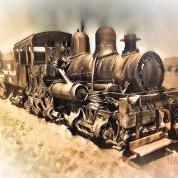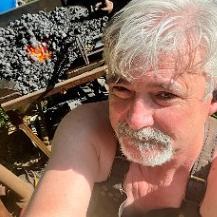
JME1149
Members-
Posts
381 -
Joined
-
Last visited
Profile Information
-
Gender
Not Telling
-
Location
Pittsburgh-ish, PA
Recent Profile Visitors
5,404 profile views
-
Nicely done, the twists look to be pretty even which is an accomplishment over that length.
-
My "acquired" anvil. Little help with ID?
JME1149 replied to JDinOH's topic in Anvils, Swage Blocks, and Mandrels
Is that a boss sticking out under the tail, in the area of the hardy hole? And is there an indent along the back foot? The general shape has me thinking it might be a Badger. -
From what we can see, it looks to be in good condition. The problem is, we can't see the important parts, being the fan blades and internal gears. We don't need to see them to gauge if there is a major issue though. Does it turn freely? Is there any excessive grinding noises when turning? It will be "noisy", but there shouldn't be any grinding, rattling, clunking type sounds. As for the oiling, that little brass fitting shown in the next to last photo is the oiler port. Should be a spring loaded cap. Pull it up, squirt a little motor oil in it before use and you should be good to go. These don't take a lot of oil, and it splashes around inside to lube everything. If you put too much oil in it, it will just leak out, so you can't really put too much in. For mounting, look at your last photo, That 3 inch diameter (or so) projection with the hole through it is where you would mount it. Take a 2X4, drill a hole through the side and put a bolt in and tighten it down. Good to go. The oiler port should be positioned roughly top dead center when mounted. (The oil drops down onto the main gears when the handle is rotated. Hope this helps.
-
What does it sound/feel like when you turn the handle the other direction (clockwise)? It could just be that the worm gear is worn for one particular direction turning. Did you grease the ball bearings or anything else while you were doing the cleanup? It could be that the grease is adding resistance, same with the gear oil. Maybe it's just too thick and a 30 weight oil might make it turn easier. It's a beauty though.
-
Remarkable consistency is not always good
JME1149 replied to rockstar.esq's topic in The Business Side of Blacksmithing
Out of curiosity, how has their performance been on the contract? Or did it never get to that point with this vendor? I've had a similar situation but on the actual contract side of things. Vendor's upfront paperwork is never correct the first time and often not the second or third times either, and the post-production certifications are no better. The product itself doesn't appear to be a problem, they just can't get the paperwork right. Result was a no confidence vote from our management and customers and they are not going to be seeing another order. I don't have the time for hand-holding to walk them through all the issues when there are more competent companies out there. Cheapest is not always the best value. -
It has the shape of a Trenton, if you look at the anvil review by brand category and Trenton History, the solid wrought circle matches. What you are calling a "P" could be the top part of the R. Looks like the front edge of the front foot was flame cut to fit the stand. That's where the serial number would have been. My vote is Trenton.
-
One more caution, if you do cut dry, the dust may get sucked into your saws motor and all that abrasive in the gears and bearings can ruin it.
-
Steel scrap rate is maybe what, 5 cents a pound, so they're worth at least $15 each if you take them to the scrapyard and unload them. I can buy a new, quality 143 pound swage block (14" square X 4" thick) from Holland Anvil already finished for $500. I'd be really surprised if you could have them cut commercially by a machine shop for anything that would make it economical, let alone profitable for resale, but if somebody is looking for a custom piece normal pricing doesn't apply. If you had your own machine shop and could cut them in your spare time, maybe you could make a couple bucks. If the sides are fairly good, they could make a nice improvised anvil as-is. A 4.5" X 18" working face has lots of possibility, with a substantial mass below it. Stand them on edge and you could use the different faces for different purposes (grind/machine your swage depressions on the side faces). Without knowing a material grade or hardness of the plates as they sit, it's tough to make any better recommendation.
-
I'd think that starting with a 1/8" wide slot punch, your sidewall legs would be around 3/8" - 7/16" wide each, so you could use this mass to your advantage when you go to thin the wall down to that 1/4" target. Sounds like you're on the right path and a few more tries will get you closer to your desired end result.
-
After you punch the slot, start with a small, tapered drift, think of something like a center punch, to gradually open the slot into a hole shape, start in the middle of the slot. Continue using a tapered drift to gradually expand the slot into a fully formed hole, flipping the part over frequently and working over the pritchel or hardy holes will help support the material as you are drifting the hole. Go back and re-read my initial response to this thread, with your experience now it might make a little more sense what I was trying to explain on slot size and placement for the initial punch.
-
Congrats! Looks good to me. How did you do the eye hole? Punch, slit & drift, drill?
-
The drifting shouldn't change the thickness at all. It should spread the width. If you slit it, you'll have two legs roughly 1/2" wide, still 1/4" thick. As you spread the legs apart, the overall width will increase, the length will decrease, but the thickness remains the same. The legs would individually still be 1/2" wide, so you would have to thin them out which would in turn increase that 1/4" thickness. The volume stays the same, you're just moving the metal from one place to another. Rather than starting with a slitting punch, I'd be more inclined to use a slot punch, something like a 1/4" wide X 1-1/8" long, rounded ends, positioned a little more than 1/4" from the end. As the hole expands and rounds-out, you have less adjusting to do on the width around the hole. This would have less impact on the pattern as well.
-
Be careful when forging it, that hole can act like a steam cannon if you quench the rod. Caution where the cold end is pointing.
-
I believe I will try to make a steel faced WI hammer
JME1149 replied to Donal Harris's topic in Hand Hammers
One piece should be roughly one pound, so depends on how big of a hammer you want. For a general forging hammer, probably want to forge weld 3 - 4 pieces together into one block then start the shaping process. I would think squaring each up then attaching two together (twice) then attaching those together would be the way I would approach it.


